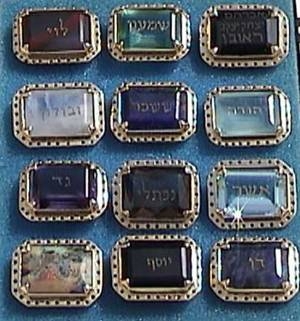This pair of chapters is pretty much taken up with the description of the priestly clothing to be made for Aaron (and his successors) to wear when undertaking priestly duties, and of the seven day ritualised ordination of Aaron and his sons. If the Tabernacle was IKEA, I'm not quite sure what this outift relates to, but the instructions are every bit as complex, detailed and precise.
The striking aspect of the garments, apart from their function as a "glorious adornment" is their symbolic function, exemplified by the ephod, decorated with twelve stones, each with the name of one of the tribes carefully engraved/inscribed upon it. Clearly graven writing came in a different category from graven images...
Remembrance
The twelve stones on the breastplate were to serve as a reminder to the priest, Aaron and his successors, of who it was they were representing. They could not enter God's presence without carrying close to their hearts, literally and metaphorically, the twelve tribes of Israel. The priest needs to remember what it is they are about, that they are the 'bridge', the 'intercessor', the 'go-between' linking earth and heaven, humanity and God. Never forget who it is you serve/represent and what is entrusted to you.
Close to the Heart
The urim and thummim, the dice used for decision making, a practice that seems to us impossibly unreliable, were to be kept close to the priest's heart. Decisions were serious matters, not simply (even if it may seem so to us) a roll of the dice to determine the fate of another. There should be a heart element to the decision making, not a cold, callous appraisal and a detatched decision. A call to love those who come seeking guidance, compassion for and empathy with those whom the priest serves.
Bells and Pomegranates
The idea of a deity who needs to be alerted to the arrival of a priest by the jingling of bells is hilarious and bemusing. The idea that sneaking up on God unwares puts the priest in danger is as terrifying as it is ridiculous. Yet this, it seems is the primary purpose of the bells.
It seems crazy, and yet... perhaps there is something about preparing oneself to approach God, about due humility, about taking seriously what is about to be enacted. Perhaps it is a helpful corrective to the casual, chummy way that prayer and praise are sometimes approached and expressed in our own time... the careless language of extempore prayers that open with phrases such as "... yes 'n' God...". Perhaps, too, a reminder, were one needed, of the sacred responsibility of intercession, of carrying to God prayers for others and for each other... that this is huge matter. I am always impressed by the seriousness with which those on our Prayers Rota take this task, the careful choice of words, the pacing of delivery, the selection of topics.
The purpose of the pomegranates is less clear, but whenever I read this verse, and indeed whenever I preach around Pentecost, I am reminded of words I first heard more than half a lifetime ago thay suggested that the bells and pomegranates could be seen as symbolising the balancing of the 'gifts of the Spirit' with the 'fruit of the Spirit'... the one noisy, the other silent yet each necessary. I've always felt that was a helpful interpretation, hence why I share it every time it comes to mind!!
Sacred Vestments
When I was on my student placement with a Roman Catholic priest, he took me into the Sacristy and showed me the contents of the press where the vestments were stored... chasubles and copes, tabbards, manacles, stoles, and so on. Thousands of pounds worth of richly decorated garments, colour coded to match the liturgical year, and sized to fit no-one in particular and anyone in general.
These were not his vestments, aside from some clerical shirts, he had a couple of black cassocks edged in red (he was a Monsignor) and a couple of alb-cassocks (white/off white pull on over the head things). These vestments belonged to the church and were for the use of whichever priest needed them. So if Father Paul had a day off and Father John led Mass, the same garments would be worn... and given Father Paul was skinny and Father John tubby, the one size fits all nature of the clothes was clearly demonstrated!!
Joking aside, there was something important being expressed here, and very different from the practices in Anglican and non-Conformist churches where clergy do robe, and wear vestments created specifically for them. Check out the websites of any clerical outfitter and you will see the huges range of possibilities.
In the Roman Catholic tradition, as in ancient Israel, it is the role that attracts the outfit, not the individual. There are certain roles for which I choose to wear a clerical shirt. The origins of why I do so are not especially honourable, but in the practices of the Roman Catholic church, and in the robes of Israelite Priests, I find a justifiable and helpful meaning: as I put on the shirt, so I 'put on' the Church, I become a symbolic representative not of myself (though of course who I am shapes everything I do or say) but of 'us', of Body of Christ. I have no desire to dress up in robes or stoles, see no purpose for them in my own ministry, but as I re-read Exodus, I am reminded that others may legitimately think differently.
I wonder, what are the symbols, literal or otherwise, that serve to remind what it is I am called to do and to be? What might form my 'ephod' take, were I to have one? What might be on yours...?
